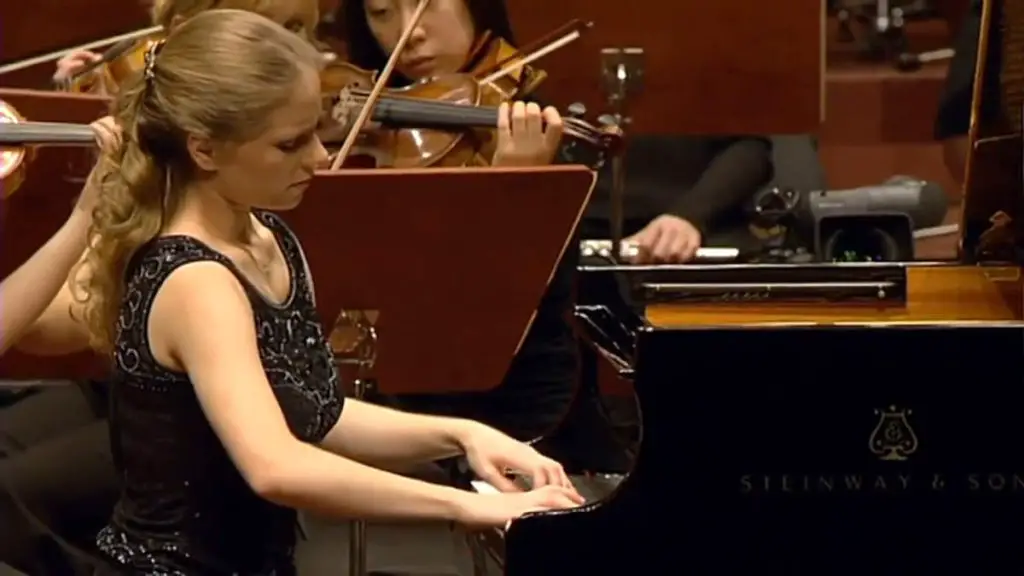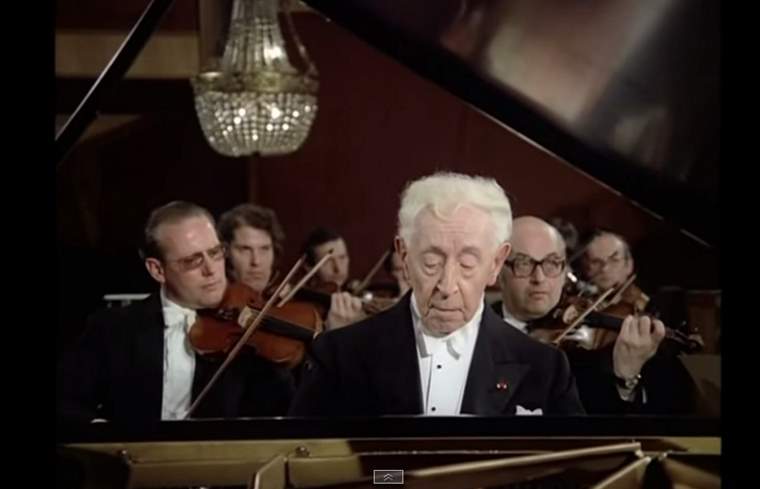Accompanied by the Oslo Philharmonic Orchestra, the Norwegian pianist Liv Glaser performs Edward Grieg’s Piano Concerto in A minor, Op. 16. Conductor: Herbert Blomstedt. A wonderful historic performance of the famous piece. Recorded at the Bergen International Festival in 1961.
Edward Grieg’s Piano Concerto
Edvard Grieg’s Piano Concerto in A minor, Op. 16, is a distinguished piece in the classical music repertoire, celebrated for its expressive depth and distinctive Norwegian flavor. Composed in 1868, when Grieg was just 25 years old, this concerto stands as his only completed concerto and is one of the most popular piano concertos ever written.
The concerto opens with a dramatic flourish, immediately capturing the listener’s attention. It’s marked by a blend of lyrical melody and vigorous rhythm, characteristics that reflect Grieg’s Norwegian heritage. The work is imbued with the spirit of Norwegian folk music, though not directly quoting any specific folk tunes. This influence is evident in the concerto’s rhythmic drive and its use of dance-like elements, which give it a distinctly nationalistic flavor.
Grieg’s Piano Concerto is also noted for its technical demands on the soloist. The piano part is both challenging and expressive, requiring a high level of virtuosity. The concerto’s construction shows Grieg’s skill in weaving together the solo piano and orchestral parts, creating a dialogue between them rather than merely having the orchestra accompany the piano. This interplay adds to the concerto’s dynamic and dramatic character.
The work was revised several times by Grieg throughout his life, reflecting his evolving style and maturation as a composer. Each revision brought subtle changes that enhanced the concerto’s effectiveness and showcased Grieg’s meticulous attention to detail.
The concerto quickly gained popularity after its premiere and has remained a staple in the concert repertoire. Numerous renowned pianists have recorded it and continues to be a favorite among both performers and audiences. Its enduring appeal lies in its blend of lyrical beauty, its evocative Norwegian character, and its passionate, romantic spirit.
Movements
There are three movements. With start times in the video:
- Allegro molto moderato 0:30
- Adagio 13:55
- Allegro moderato molto e marcato 20:50
1. Allegro molto moderato
The first movement of Edvard Grieg’s Piano Concerto in A minor, Op. 16, is a compelling and dynamic piece that sets the tone for the entire concerto. It begins with a famous flourish: a dramatic timpani roll followed by a bold, descending piano passage. This arresting introduction quickly establishes the movement’s energetic and passionate character.
Following the initial flourish, the movement unfolds into a lyrical and expressive theme, showcasing Grieg’s melodic gifts. The piano and orchestra engage in a rich dialogue, with the solo piano often taking the lead while the orchestra provides a lush and supportive backdrop. The interplay between the piano and the orchestra is a key feature of this movement, characterized by a constant exchange of musical ideas.
The first movement follows the traditional sonata form, a common structure for the first movements of concertos during the Romantic era. This form includes an exposition, development, and recapitulation, offering a balanced and coherent musical journey. In the exposition, the main themes are presented, which are then developed and explored in various ways in the development section. The recapitulation brings back the main themes, often with some variation, before leading to a conclusion.
One of the striking aspects of this movement is its use of Norwegian folk elements, albeit in a subtle and stylized manner. Grieg incorporates these elements into the rhythmic and harmonic fabric of the movement, contributing to its distinctive national character.
Throughout the first movement, there’s a sense of dramatic contrast. Grieg masterfully shifts between moments of fiery intensity and passages of tender lyricism, creating a rich emotional landscape. The movement culminates in a virtuosic cadenza for the solo piano, a section that allows the pianist to showcase their technical skill and interpretative abilities. This cadenza leads into the final section of the movement, where the main themes are revisited and the movement ends with a sense of resolution and grandeur.
2. Adagio
The second movement of Edvard Grieg’s Piano Concerto in A minor is a stark contrast to the energetic and dynamic first movement. This movement, typically marked Adagio, exudes a serene, lyrical quality that showcases Grieg’s skill in crafting beautiful, expressive melodies.
Characterized by its gentle and reflective nature, the second movement opens with a soft, delicate theme introduced by the strings. This theme sets a tranquil and somewhat introspective tone. The piano enters quietly, further developing the theme with a sense of tender expressiveness. The interplay between the piano and the orchestra is more subdued in this movement compared to the first, with the orchestra providing a warm, supportive backdrop to the piano’s melodic explorations.
Throughout the movement, Grieg employs rich harmonies and subtle orchestration to create a mood that is both romantic and introspective. The piano part, while not as technically demanding as in the first movement, requires a high degree of expressive sensitivity from the performer. The pianist must convey the movement’s delicate nuances and emotional depth, making the performance both a technical and an emotional endeavor.
One of the notable aspects of this movement is its use of dynamics and tempo. Grieg masterfully varies these elements to enhance the emotional impact of the music. The movement may contain moments of slight crescendo or a subtle quickening of pace, but these are always within the context of its overall tranquility.
The second movement serves as a beautiful interlude between the vigorous first movement and the spirited finale. It provides a moment of calm and reflection, allowing listeners to immerse themselves in Grieg’s lyrical world. The movement concludes softly, often leading seamlessly into the energetic third movement, creating a well-rounded emotional and musical experience.
3. Allegro moderato molto e marcato – Quasi presto – Andante maestoso
The finale of Edvard Grieg’s Piano Concerto in A minor is a vibrant and spirited conclusion to the concerto. Marked Allegro moderato molto e marcato, this movement is characterized by its lively rhythm, robust energy, and a sense of joyful exuberance.
After the reflective and serene second movement, the third movement brings a return to the dynamism and vitality reminiscent of the first movement, but with its own distinct character. It opens with an energetic theme introduced by the orchestra, setting the stage for a movement filled with rhythmic drive and excitement. The piano soon joins in, taking up the theme and adding its own virtuosic flair.
This movement is notable for its rhythmic vitality and its use of dance-like elements, which are reminiscent of Norwegian folk music. These elements give the movement a distinctive nationalistic character, a hallmark of Grieg’s style. The music is lively and rhythmic, with a robust and cheerful quality that is infectious.
The piano part in this movement is particularly challenging, requiring not only technical skill but also the ability to convey the music’s exuberant spirit. The pianist must navigate through rapid passages, intricate fingerwork, and powerful chords, all while maintaining a sense of rhythmic precision and musicality.
Grieg’s orchestration in this movement is masterful, with the orchestra playing a key role in building the movement’s energetic atmosphere. The interaction between the piano and the orchestra is lively and engaging, with the two often engaging in a musical dialogue that adds to the movement’s dynamic character.
One of the highlights of this movement is a section in the middle where the tempo slows down and a lyrical, somewhat nostalgic theme is introduced. This provides a moment of contrast and reflection before the movement returns to its lively pace.
The movement builds towards a grand and triumphant conclusion, with the piano and orchestra coming together in a powerful finale. This ending is both exhilarating and satisfying, bringing the concerto to a close with a sense of joy and accomplishment.
Liv Glaser
Liv Glaser (born 23 September 1935 in Oslo, Norway) is a Norwegian pianist, music teacher, and professor at the Norwegian Academy of Music, the daughter of violinist Ernst Glaser and pianist Kari Marie Aarvold Glaser, and married in 1971 to the director of culture Carsten Edvard Munch (1927-2005).
She was raised in a family where both parents were professional musicians. From 1952 to 1956 she studied with classical pianist Robert Riefling, and later with Vlado Perlemuter in Paris. Her debut concert was in Oslo in 1960. She has lectured at the Norwegian Academy of Music since 1973, where she was appointed professor in 1994. Her paternal half-brother is cellist Ernst Simon Glaser.
![Liv Glaser performs Edward Grieg's Piano Concerto [1961]](https://cdn-0.andantemoderato.com/wp-content/uploads/2023/11/Liv-Glaser-Grieg-Piano-Concerto-1961-1024x576.jpg)
Glaser has cooperated with the conductor Sir John Barbirolli. Having been a soloist in Prokofiev’s third piano concerto, in Oslo under his taktstock, he invited her to Hallé Orchestra in Manchester in 1962, with the same concert, and in 1963 she played Grieg’s Piano Concerto with him and Hallé Orchestra on tour.
Glaser’s repertoire ranges widely. She has played a lot of French music that she became close to during their studies in Paris. The classical repertoire might have been her closest, but she has also performed much Norwegian music, especially chamber music Grieg and compositions for piano solo, and has for many years been a regular performer at the Festspillene i Bergen (Bergen International Festival). She has collaborated with Arve Tellefsen for several years.
Glaser was appointed Commander of the Royal Norwegian Order of St. Olav in 2018.
Honors
- 1988: Gammleng-prisen in the category Classic
- 2004: Lindeman-prisen
Sources
- Piano Concerto (Grieg) on Wikipedia
- Liv Glaser on Wikipedia
![Liv Glaser performs Edward Grieg's Piano Concerto [1961]](https://cdn-0.andantemoderato.com/wp-content/uploads/2023/11/Liv-Glaser-Grieg-Piano-Concerto-1961.jpg)



